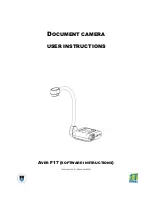
36
C H A P T E R 4
Teach Your Camera New Tricks
f
The sensitivity of the Zebra feature can be controlled by
UnderExposure
Threshold
and
OverExposure Threshold
. The range goes from
0
(low sen-
sitivity) to
32
(high sensitivity).
f
The next two options only apply to the Zebra blink modes. When a
Zebra pattern is drawn, both the Canon indicators and the CHDK indica-
tors (for example, the DOF calculator) are erased by the pattern. To re-
store these information items during the blink pauses, set the options
Restore Original Screen
(for the Canon items) and
Restore OSD
(for the
CHDK items).
f
The option
Draw Over Zebra
applies to all Zebra modes. When this option
is set to value
OSD
, all OSD information items will be drawn on top of
the Zebra pattern and thus remain visible. When set to
Histo
, only the
histogram is drawn on top of the Zebra pattern. When set to
Nothing
,
the Zebra pattern will be drawn on top of all items. With a blinking Zebra
pattern, I would rather set this parameter to
Nothing
and enable the
previous two options (
Restore original screen
and
Restore OSD
). This way,
both the Zebra pattern and the indicators are completely visible.
f
Finally, there is a special Zebra mode that can be switched on by
RGB
zebra
. This mode displays overexposed areas in different colors depend-
ing on which color channel is overexposed. For example, if the blue
channel is overexposed, the Zebra pattern will be blue; if both the red
and green channels are overexposed, the Zebra pattern will be yellow
(red+green), and if all channels are overexposed, the Zebra pattern will
be black. The drawback of this mode is that it cannot show under-
exposed areas.
4.3.5
High-speed
photography
One amazing feature of the CHDK is the provision for ultra-short shutter
speeds. Before we go into the details, let’s take a look at general shutter
technology.
Traditional cameras from the analog era use mainly two types of shut-
ters. One is the focal plane shutter, which is also used in DSLRs. Here, two
curtains move across the focal plane, and the light passes through a slit
between the two curtains. The width of the slit determines the exposure
time. By choosing a very narrow slit, a focal plane shutter can offer fast
shutter speeds down to 1/8000 sec. The downside of this technique is that
the slit needs time to travel across the focal plane. Fast-moving objects often
appear stretched or contracted depending on the direction of the object’s
movement in relation to the slit’s movement. Another problem with this
type of shutter is flash photography. The entire sensor area must be uncov-
ered by the curtains while the flash is emitting light in order to avoid uneven
illumination. So shutter speeds cannot be very high when flash is used.
Содержание Camera
Страница 1: ......
Страница 2: ...The Canon Camera Hackers Manual ...
Страница 3: ......
Страница 4: ...Berthold Daum The Canon Camera Hackers Manual Teach Your Camera New Tricks ...
Страница 19: ...10 CH APTER 2 Cameras and Operating Systems ...
Страница 25: ...16 CH APTER 3 ...
Страница 85: ...76 CH APTER 4 Teach Your Camera New Tricks ...
Страница 213: ...204 CH APTER 6 ...
Страница 253: ...244 AP PENDIX ...
















































